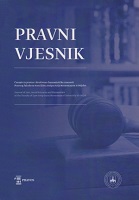DISKRIMINATORNI ASPEKTI POLITIKE PLAĆA U JAVNOM SEKTORU U REPUBLICI HRVATSKOJ, S NAGLASKOM NA POJEDINE KATEGORIJE ZAPOSLENIH U DRŽAVNIM TIJELIMA I JAVNIM SLUŽBAMA – LIJEČNIKA, SVEUČILIŠNIH NASTAVNIKA I SURADNIKA, SUDACA I SUDSKIH SAVJETNIKA
DISCRIMINATORY ASPECTS IN PUBLIC SECTOR SALARY POLICY IN THE REPUBLIC OF CROATIA WITH REFERENCE TO SELECTED CATEGORIES OF EMPLOYEES IN PUBLIC AUTHORITIES AND PUBLIC SERVICES
Author(s): Vatroslav ZovkoSubject(s): Politics and society, Higher Education , State/Government and Education, Social Theory, Health and medicine and law, Sociology of Education, Sociology of Law, Corruption - Transparency - Anti-Corruption, Labour and Social Security Law
Published by: Pravni fakultet Sveučilišta Josipa Jurja Strossmayera u Osijeku
Keywords: salaries; higher education; health care; judiciary; discrimination; public services;
Summary/Abstract: Public sector salary policy aims at making the salary system more transparent and keeping it at the same level in different public authorities and services. In practice, governing bodies use salary policy to demonstrate their priorities in managing the entire public sector. Such an approach frequently carries particular discriminatory features. The paper aims at presenting the system of determining the salaries of employees in public authorities and public services and giving an overview of the currently applicable legal framework in this regard. Considering the size of the public sector, a salary analysis was made on a sample of the salaries of university teaching personnel, doctors and judges. The criteria for selecting the jobs in question in the sample are the features common to each profession: independence in decision-making and work as set by the legal framework, a clear hierarchy of advancement in the profession, budget financed salaries and external evaluation related to potential advancement within the system. For each group of the aforesaid categories of employees, the similarities and differences in the salary determination system are shown. Accordingly, the extent to which the principle of equal pay for equal work is respected as stipulated by the provisions of the Labour Law, as well as potentially discriminatory elements in the determining salaries system within the public sector are established.
- Issue Year: 39/2023
- Issue No: 1
- Page Range: 53-77
- Page Count: 25
- Language: Croatian

